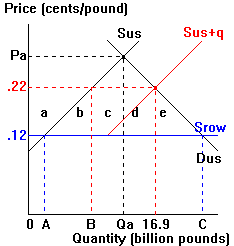|
|
Tuesday, January 29, 2013 |
Elasticity examples
1. Online:
Tax incidence (Java)
<http://faculty.oxy.edu/whitney/java/stepview/ec250/d023c_TaxIncidence.html>
Note: When you see the 'Draw' button, click it and then click the 'Stop' button
to see the end result (because the 'Draw' function no longer works as intended).
2. Elastic v. Inelastic Demand
(1) On Wednesday, Cineplex Odeon raised ticket
prices from $6 to $6.50 in Los Angeles just as the three summer blockbusters --
"Rambo III," "Crocodile Dundee II" and "Willow" began stiff
competition for ticket buyers. However, while Tuesday's pre-hike box-office
receipts...totaled $5,010 for both screens showing "Willow," on Wednesday, the
first day of the increases, receipts dropped to $3,294. ("Price hike: coming soon to
a theater near you?" Los Angeles Times, May 28, 1988)
(2) New York city's taxi fleets have found the fare
increase granted last fall inadequate and are preparing to seek a new increase, according
to Taxi News, the industry's paper. The 17.5 percent fare increase that went into effect
in November has produced only about a 10 to 11 percent increase in gross revenues rather
than the 17.5 percent that the Taxi and Limousine Commission had predicted, the paper
said. ("Despite Fare Rise, Taxi Fleets Report New Losses Again." New York
Times, 1975)
How much does the amount of smoking respond to changes in the price
of cigarettes? Economists have attempted to answer this question by studying what happens
when the tax on cigarettes changes. (3) They have found that a 10 percent
increase in the price causes a 4 percent reduction in the quantity demanded. (4)
Teenagers are found to be especially sensitive to the price of cigarettes: A 10 percent
increase in the price causes a 12 percent drop in teenage smoking. (N. Gregory Mankiw. Principles
of Microeconomics, 2ed., 2001, p.73)
Question: Which, if any, of the four examples above
illustrate inelastic demand?
3. Elasticity and spending
Two drivers--Tom and Jerry--each drive up to a gas station. Without paying
any attention to the price of gas, each one places an order. Tom says, "I'd like
10 gallons of gas." Jerry says, "I'd like $10 of gas." What is the value of
Tom's elasticity of demand for gas? What is the value of Jerry's elasticity of
demand for gas?
4. U.S. sugar quotas
 Use the letters and numerical values from the diagram to the right to help you complete
the information in the table below.
Use the letters and numerical values from the diagram to the right to help you complete
the information in the table below.
Sus = the supply curve of domestic producers
Srow = the free-trade supply curve by the "rest of the world"
(ROW), showing that we can buy as much sugar as we please at the going world price
Sus+q = the supply of domestic producers plus the quantity allowed in
under the quota (q).
| |
No trade |
Free trade |
Trade with quota |
| Price |
Pa |
$.12 |
|
| Consumption |
Qa |
|
|
| Production |
Qa |
|
|
| Imports |
0 |
|
|
Comparing the quota to free trade, indicate the areas in the diagram corresponding to:
the change in U.S. consumer surplus: _________
the change in U.S. producer surplus: _________
Suppose that between the free-trade and quota price the arc own-price elasticity of
demand for sugar is 0.35. Use this information to calculate actual numerical answers to
each of the following:
quantity of sugar consumed under free trade (C in the diagram):
_________ billion pounds
(Hint: use the arc-elasticity formula and rearrange terms to solve for
C.)
change in consumer surplus caused by the quota: $_________ billion
dollars
 Use the letters and numerical values from the diagram to the right to help you complete
the information in the table below.
Use the letters and numerical values from the diagram to the right to help you complete
the information in the table below.